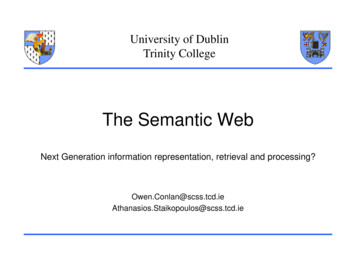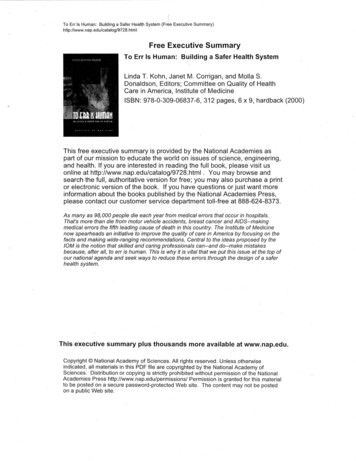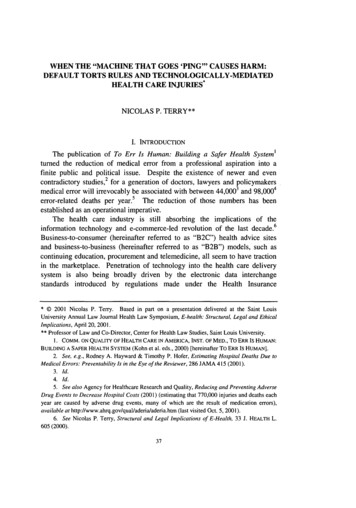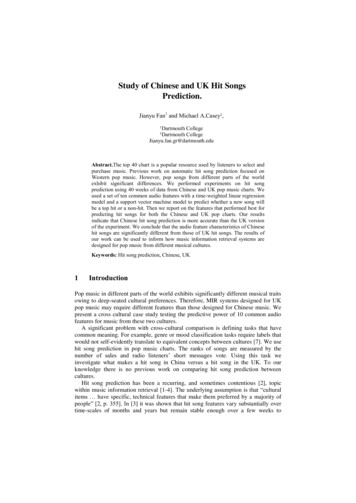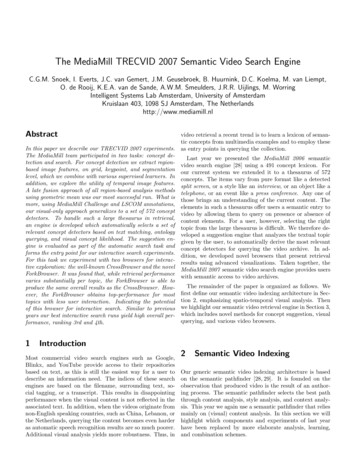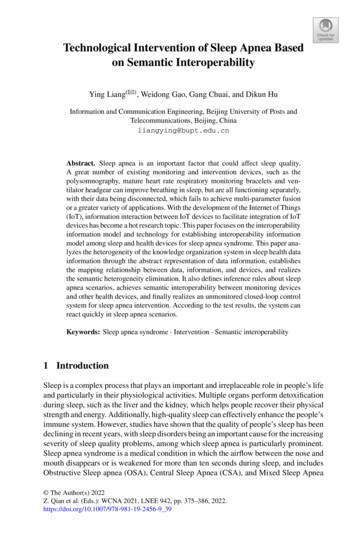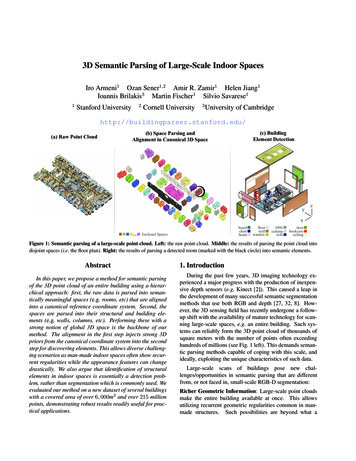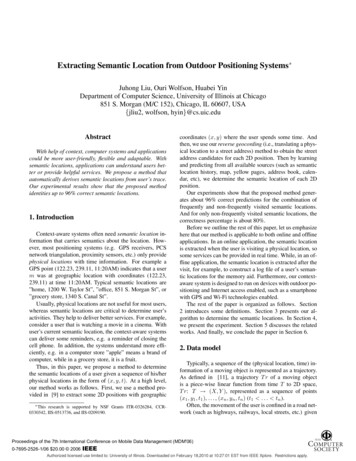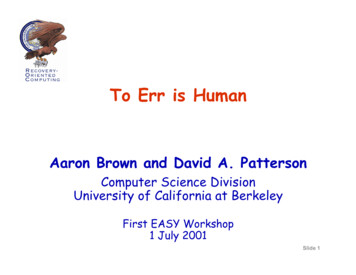
Transcription
To Err is HumanAaron Brown and David A. PattersonComputer Science DivisionUniversity of California at BerkeleyFirst EASY Workshop1 July 2001Slide 1
The dependability challenge Server system dependability is a big concern– outages are frequent, especially for Internet services» 65% of IT managers report that their websites wereunavailable to customers over a 6-month period 25%: 3 or more outages» EBay: entire site is fully-functioning 90% of time– outages costs are high» NYC stockbroker: 6,500,000/hr» EBay: 225,000/hr» Amazon.com: 180,000/hr» social effects: negative press, loss of customers who“click over” to competitorSource: InternetWeek 4/3/2000, EBay daily logs (thanks to Patricia Enriquez for data)Slide 2
Humans cause failures Human error is largest single failure source– HP HA labs: human error is #1 cause of failures (2001)– Oracle: half of DB failures due to human error (1999)– Gray/Tandem: 42% of failures from humanadministrator errors (1986)– Murphy/Gent study of VAX systems (1993):% of System Crashes100%OtherCauses of system 85Sources: Gray86, Murphy95Time warefailure Slide 3
Humans cause failures (2) More data: telephone network failures– from FCC records, 1992-1994Number of OutagesMinutes of FailureHuman-companyHuman-externalHW failuresAct of NatureSW failureVandalism– half of outages, outage-minutes are human-related» about 25% are direct result of maintenance errors byphone company workersSlide 4Source: Kuhn, IEEE Computer 30(4), 1997.
Humans cause failures (3) Human error rates during maintenance ofsoftware RAID system– participants attempt to repair RAID disk failures» by replacing broken disk and reconstructing data– each participant repeated task several times– data aggregated across 5 participantsError typeFatal Data LossWindowsSolaris0Linux00Unsuccessful Repair0System ignored fatal input0User Error – Intervention Required0000User Error – User Recovered0000000Total number of trials353331Slide 5
Humans cause failures (4) Errors occur despite experience:3Number of errorsWindowsSolarisLinux210123456789Iteration Training and familiarity can’t eliminate errors– mistakes mostly in 1st iterations; rest are slips/lapses System design affects error-susceptibility Slide 6
Don’t just blame the operator! Psychology shows that human errors areinevitable [see J. Reason, Human Error, 1990]– humans prone to slips & lapses even on familiar tasks» 60% of errors are on “skill-based” automatic tasks– also prone to mistakes when tasks become difficult» 30% of errors on “rule-based” reasoning tasks» 10% of errors on “knowledge-based” tasks that requirenovel reasoning from first principles Allowing human error can even be beneficial– mistakes are a part of trial-and-error reasoning» trial & error is needed to solve knowledge-based tasks like problem diagnosis and performance tuning» fear of error can stymie innovation and learningSlide 7
What can we do? Human error is inevitable, so we can’t avoid it“If a problem has no solution, it may not be a problem,but a fact, not to be solved, but to be coped with overtime” — Shimon Peres We must build dependable systems that cancope with human error– and even encourage it by supporting trial-and-error– allow operators to learn from their mistakes We must build benchmarks that measuredependability in the face of human error– “benchmarks shape a field” and motivate progressSlide 8
Dependability benchmarks & humans End-to-end dependability benchmarks (“TPC”)– model: complete system evaluated for availability/QoSunder injected “upset-load”– goal: measure overall system dependability includinghuman component, positive and negative– approach: involve humans in the benchmark process» select “best” administrators to participate» include maintenance, upgrades, repairs in upset-load– benefits: captures overall human contribution todependability (both positive and negative)– drawbacks: produces an upper-bound measure; hard toidentify human contribution to dependabilitySlide 9
Dependability benchmarks (2) Dependability microbenchmarks– model: component(s) tested for susceptibility to upsets– goal: isolate human component of dependability» system’s propensity for causing human error» dependability impact of those errors– approach: usability experiments involving humans» participants carry out maintenance tasks and repairs» evaluate frequency and types of errors made» evaluate component’s resilience to those errors– benefits: direct evaluation of human error impact ondependability– drawbacks: ignores positive contribution of humans;requires large pool of representative participantsSlide 10
Human participation in benchmarks Our approaches require human participation– significantly complicates the benchmark process– hard to get enough trained admins as participants– makes comparison of systems difficult Can we eliminate the human participation?– end-to-end benchmarks need a human behavior model» if we had this, we wouldn’t need system administrators!– microbenchmarks require only a human error model» but, human errors are inherently system dependent function of UI, automation, error susceptibility, .» may be possible to build a model for a single system,but no generalized benchmark yet» good place for future research . . .Slide 11
Dependable human-operated systems Avoiding human error– automation: reducing human involvement» SW: self-tuning, no-knobs, adaptive systems, .» HW: auto-sparing, configuration, topology discovery, .» but beware of automation irony!– training: increasing familiarity with system» on-line training on realistic failure scenarios in aprotected sandbox– avoidance is only a partial solution» some human involvement is unavoidable» any involvement provides opportunity for errorsSlide 12
The key to dependability? Building tolerance for human error– accept inevitability of human involvement and error» focus on recovery– undo: the ultimate recovery mechanism?» ubiquitous and well-proven in productivity applications» familiar model for error recovery» enables trial-and-error interaction patterns– undo for system maintenance» “time-travel” for system state» must encompass all hard state, including hardware &network configuration» must be flexible, low-overhead, and transparent to enduser of systemSlide 13
Conclusions Humans are critical to system dependability– human error is the single largest cause of failures Human error is inescapable: “to err is human”– yet we blame the operator instead of fixing systems We must take human error into account whenbuilding dependable systems– in our system designs, by providing tolerance throughmechanisms like undo– in our dependability evaluations, by including a humancomponent in dependability benchmarks The time is ripe for human error research!– the key to the next significant dependability advance?Slide 14
To Err is HumanFor more ://roc.cs.berkeley.eduSlide 15
Backup slidesSlide 16
Recovery from human error ROC principle: recovery from human error,not avoidance– accepts inevitability of errors– promotes better human-system interaction byenabling trial-and-error» improves other forms of system recovery Recovery mechanism: Undo– ubiquitous and well-proven in productivity applications– unusual in system maintenance» primitive versions exist (backup, standby machines, .)» but not well-matched to human error or interactionpatternsSlide 17
Undo paradigms An effective undo paradigm matches the needsof its target environment– cannot reuse existing undo paradigms for systemmaintenance We need a new undo paradigm for maintenance– plan:» lay out the design space» pick a tentative undo paradigm» carry out experiments to validate the paradigm Underlying assumption: service model– single application– users access via well-defined network requestsSlide 18
Issue #1: Choice of undo model Undo model defines the view of past history Spectrum of model elinear undoflexibilityMS deletion Important choices:– undo only, or undo/redo?– single, linear, or branching?– deletion or no deletion? Tentative choice formaintenance undo40153u2utrial-and-error history patternSlide 19
More undo issues2) Representation– does undo act on states or actions?– how are the states/actions named? TBD3) Selection of undo points– granularity:» undo points at each state change/action?» or at checkpoints of some granularity?– are undo points administrator- or system-defined? Tentative maintenance undo choices in redSlide 20
More undo issues (2)4) Scope of undo– “what state can be recovered by undo?”– single-node, multi-node, multi-node network?– on each node:» system hardware state: BIOS, hardware configs?» disk state: user, application, OS/system?» soft state: process, OS, full-machine checkpoints?– tentative maintenance undo goals in redSlide 21
More undo issues (3)5) Transparency to service user– ideally:» undo of system state preserves user data & updates» user always sees consistent, forward-moving timeline» undo has no user-visible impact on data or serviceavailabilitySlide 22
Context: other undo mechanismsDesign eTransparencybranchingundo/redostate,naming TBDautomaticcheckpointsall disk & HW,all nodes &networkhighGeoplex sitefailoversingle undostate,unnamedvaries; usu.automatic entire systemcheckpointshighTape backupsingle ormultiplelinear undostatead-hoc namingmanualcheckpointsdisk (1 FS),single nodelowGoBack l naming checkpointsdisk (all),single nodelowmediumNetappSnapshotsmultiplelinear undostate,manualtemporal naming checkpointsdisk (all),single serverlowDBMS logging(for txn abort)single undosingle txn,app-levelhighUndo mech.Desiredmaintenanceundo semanticshybrid,unnamedautomaticcheckpointsSlide 23
Implementing maintenance undo Saving state: disk– apply snapshot or logging techniques to disk state» e.g., NetApp- or VMware-style block snapshots, or LFS» all state, including OS, application binaries, config files– leverage excess of cheap, fast storage– integrate “time travel” with native storage mechanismfor efficiency Saving state: hardware– periodically discover and log hardware configuration– can’t automatically undo all hardware changes, but candirect administrator to restore configurationSlide 24
Implementing maintenance undo (2) Providing transparency– queue & log user requests at edge of system, in formatof original request protocol– correlate undo points to points in request log– snoop/replay log to satisfy user requests during undo.systemlogical timeR RE EQ Qutime --- undoinvokedcurrent (real)timeREQ --- user requests An undo UI– should visually display branching structure– must provide way to name and select undo points,show changes between pointsSlide 25
Status and plans Status– starting human experiments to pin down undo paradigm» subjects are asked to configure and upgrade a 3-tiere-commerce system using HOWTO-style documentation» we monitor their mistakes and identify where and howundo would be useful– experiments also used to evaluate existing undomechanisms like those in GoBack and VMware Plans– finalize choice of undo paradigm– build proof-of-concept implementation in Internetemail service on ROC-1 cluster– evaluate effectiveness and transparency with furtherexperimentsSlide 26
Slide 9 Dependability benchmarks & humans End-to-end dependability benchmarks ("TPC") - model:complete system evaluated for availability/QoS under injected "upset-load" - goal:measure overall system dependability including human component, positive and negative - approach:involve humans in the benchmark process » select "best" administrators to participate
